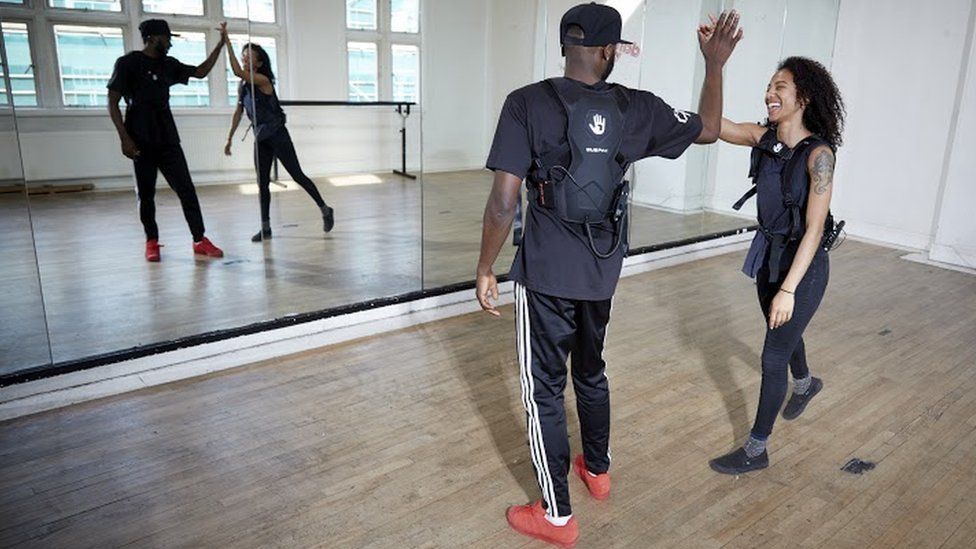The tech helping disabled people dance, run and compete
- Published

As choreographer Chris Fonseca teaches me a dance routine, the beat of the music is pumping through me.
But not through my ears. I'm wearing a SubPac, which is strapped on to my back and allows me to feel the beat of the music as it thumps through my body.
Chris is trying to replicate what it would feel like if, like him, I were deaf. And this is his aim - to give the opportunity for deaf dancers in his classes to feel the music so they can learn his choreography with ease.
"Dance classes are always so fast-paced, and without being able to hear the music you end up just being out of time," says Chris.
The SubPac, which is widely used in the music world to help music producers feel the music without damaging their ears, works by transferring low, bass frequencies directly to your body, providing the physical dimension to sound.
As soon as his aunty introduced him to music videos, dancing became a passion for Chris. But when he became deaf at a young age, after having meningitis, he thought his dreams of dancing and choreography were over.
Through his love of dance, Chris persevered, joining dance classes at the back and allowing his natural ability to shine through.
But he knew that not every deaf dancer would be as confident as him without being able to hear the music.
James Williams, who does business development for SubPac, tells the BBC: "Giving Chris, and those with hearing impairments the ability to experience something that we all take for granted is a rare opportunity.
"Since the focus is on physicality, the SubPac is great for helping dancers with hearing problems to dance in time to the beat."
Sport for all
And technology is giving people with all kinds of disabilities the chance to stay active and keep fit.
Take Simon Wheatcroft, who lost his sight at 17.
Simon was born with the genetic degenerative eye condition retinitis pigmentosa (RP), which causes gradual deterioration of the retina. But that hasn't stopped Simon becoming an ultra-marathon runner.
"I started running for something to do. I used a guide dog to run outside or went running with other people," he says.
He has run the New York marathon and many much longer races, normally with a human guide. But what happens when you want to run solo?
In a bid to do a 155-mile ultra-marathon in the Namibian desert this May he turned to IBM Bluemix - the tech giant's app development arm - to help him create an app.
Called eAscot after his guide dog, the app uses sensors, similar to car parking sensors, and satellite navigation to help him stay on course.
A desert race can be broken down into a series of straight lines, each with its own bearing on a compass. If he veers off to the right, the app emits a high-pitched beep that increases in frequency the further away he goes. If he runs too far left, low pitch beeps warn him.
Silence means he's heading in the right direction.
"I was tired and in pain after the marathons, but I was also happy knowing I had achieved something that once seemed impossible, made possible thanks to technology," says Simon.
"What sticks with me is the feeling of accomplishment," he adds. "Being able to do something that had never been done before. To create an application in a matter of weeks that changed what was possible for visually impaired runners felt even better than completing any race."
In it to win it
Paralympians, too, are using technology to help them compete at the highest level.
Advances in 3D printing, lightweight materials and computer design are having an impact in a number of areas, from tailor-made racing wheelchairs to aerodynamic prosthetic limbs.
"The technology being used, such as 3D tech, is evolving every year and we will see a wide range of new advancements at the upcoming Paralympics that will aid those competing to achieve even greater records across all disciplines," says Nick Braund, head of tech and innovation at PHA Media.
Designworks carried out full body scans of track and field athletes in the US Paralympics team to create the sporty racing wheelchairs.
But what about assistive technology for everyday sports?
When Anthony Netto, a South African-born professional golfer and US veteran, was paralysed after being shot through the hip whilst on duty in Iraq, he thought he'd never be able to play golf again.
As a paraplegic he knew it wouldn't be possible without being able to stand. So he invented the Paragolfer, a machine that can elevate you from a sitting position to a standing position.
Initially invented in 2001, it was finally launched in April this year at Mearns Castle Golf Academy in Glasgow.
Anthony says it's transformed the prospects for people who thought they'd never be able to play the sport again.
"From tears of joy, to smiles from ear to ear, hugs and kisses for grateful heartfelt thank yous - I feel like I've made a real difference to people's lives," he says.
Nick Braund concludes: "New tech innovations like these have allowed those previously not able to take part in sport or exercise the opportunity to compete and succeed."
And that can only be a good thing.
Follow Technology of Business editor Matthew Wall on Twitter: @matthew_wall